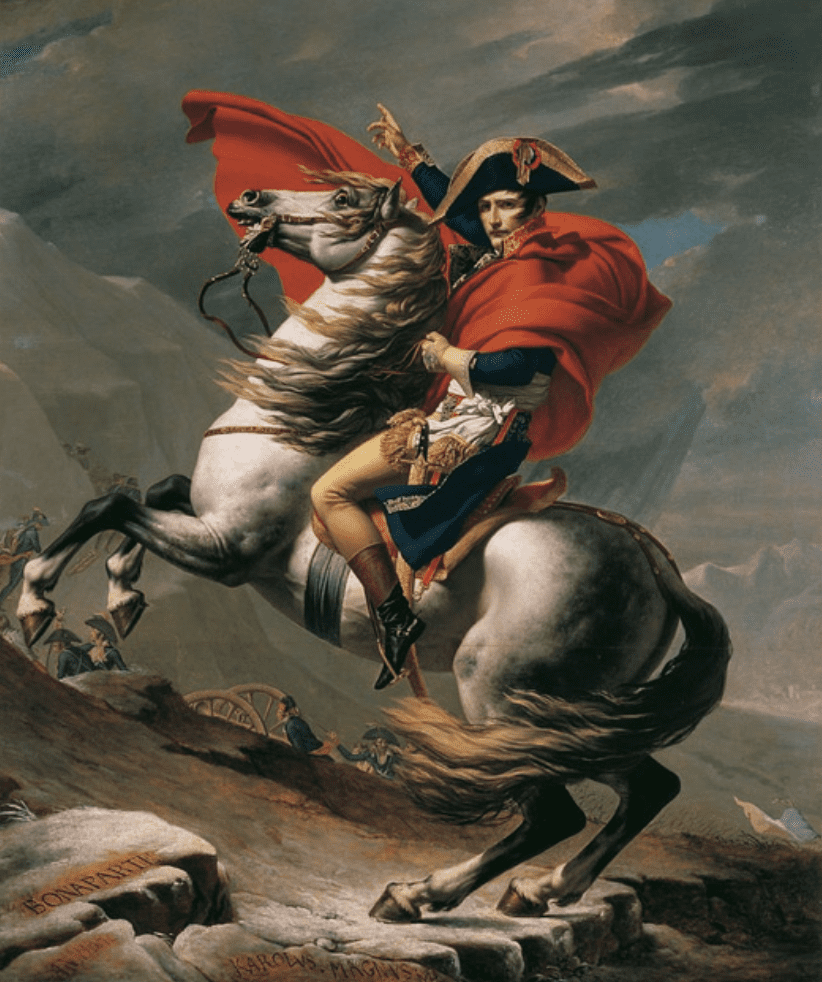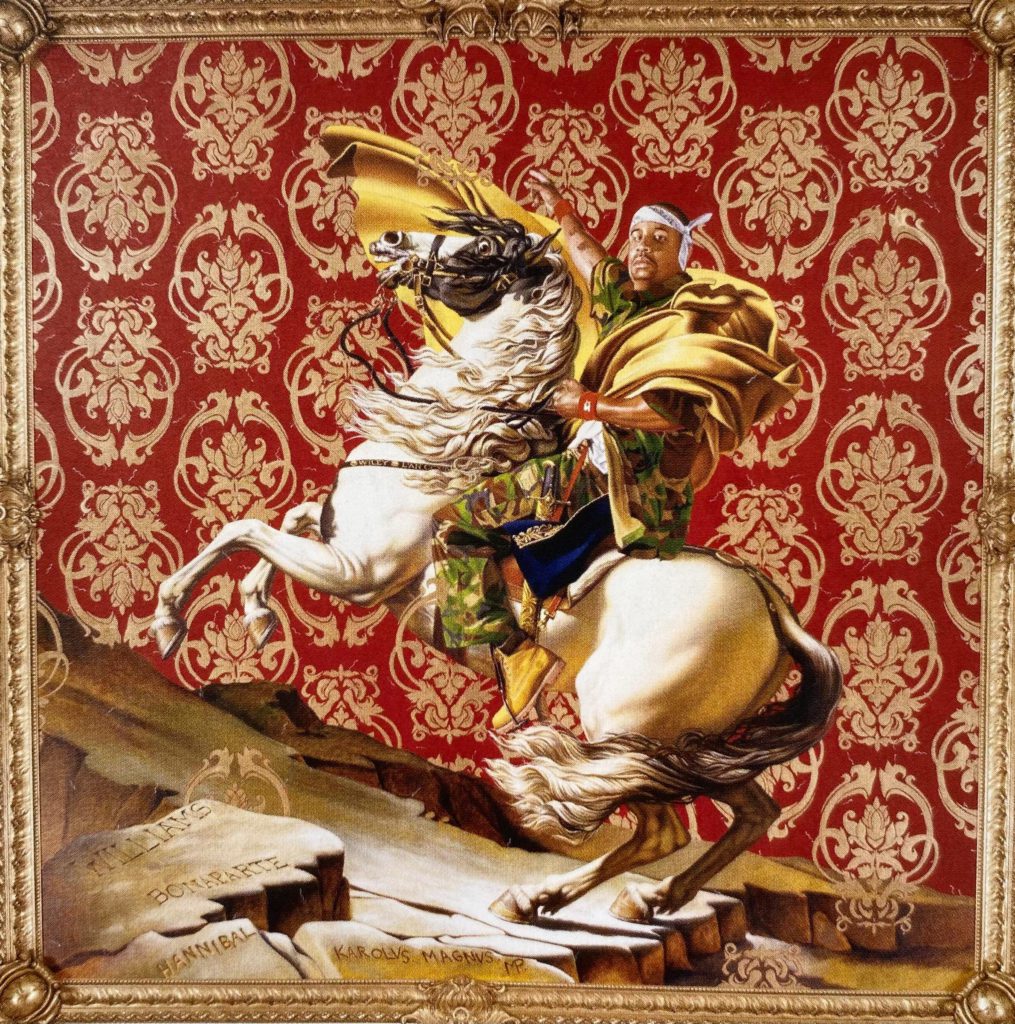What makes Kehinde Wiley’s painting Napoleon Leading the Army over the Alps a masterpiece?
- Strategic opposition in casting
- War bleeds – Africa glitters gold
- The field of power reframed
Click here for the podcast version of this post.
Kehinde Wiley’s Napoleon Leading the Army over the Alps is my favorite spinoff. Not only does American painter Wiley recreate a French masterpiece, he also makes a new one. Many of us have seen the Jacques Louis David original (below). In it Napoleon’s horse rears as his red cape dances on gusts of wind. But that’s not all that blows. So does the story that painting portrays. Like much of David’s work, it’s total fabrication. That makes it a perfect seed for Kehinde Wiley’s garden.
Wiley reworks famous historical portraits. He’s refreshed and reframed our sense of the past this way. Kehinde focused on what he called the “field of power” in familiar works. That’s because Wiley replaced the figure of authority (always white) with a young black man. He also dressed them in contemporary clothes. No matter the original painting’s time, his additions represent today’s black culture. Napoleon Leading the Army over the Alps shows a perfect example of this.
Wiley’s models were always anonymous. While the paintings he chose to deconstruct featured real historical figures. For instance, Jacques Louis David was Napoleon’s buddy. David’s portrayal in the original Napoleon Leading the Army over the Alps gives this away. Though his paintings are categorized as Historical, they were often propaganda. And this one epitomizes that. Napoleon never led an army over the Alps. The 1803 painting was pure PR. Truth was Napoleon sent his men into battle on foot and followed them after a few days… on a donkey.
Poignant Color Setting
The wallpaper’s my favorite part of Wiley’s Napoleon Leading the Army over the Alps. He replaces David’s fake, Alps background with gaudy red and gold wallpaper. It’s a dialectical new reality. Wiley lends the piece a sense of unreality. That’s enhanced by the way Kehinde overlaps the wallpaper pattern into the rock. It seems to bleed through the thick cliff where Napoleon’s horse stands. Still this showy backdrop reads as more real than David’s Alps of 1803.
This scarlet wall also parallels Jacques Louis David’s Napoleon cape. It adds dramatic flair but with a modern edge. The gold pattern ties into the Emperor’s pants and bicorn hat stripe. Wiley employs this showy setting as a juxtaposition to the natural-seeming David background. It’s a bit ironic. That’s because Jacques Louis may have painted Napoleon in front of such wallpaper. It even has a French flare. From history, we know for certain the Alps were not the actual backdrop. So, Kehinde’s absurd modern backdrop is more real than the one from Napoleon’s time.
Wiley also changes David’s red cape to gold. This gives the former red one a bloody meaning. In retrospect, it seems to symbolize the blood Napoleon shed with his conquering. Kehinde’s gilded cape, on the other hand, represents Africa’s gold mines. For most of human history Africa yielded more gold than any other continent. Wiley also adjusts the horse’s coloration. David’s horse bears a charcoal grey and brown mane. Its legs, tail, and rump are cast in dark shadows. So, although this white horse represents victory, the dark side of war remains. But Wiley’s horse shines a brilliant, innocent, cream color. Shadows only cast upon its tail and hind legs.

That getup reigns as the best thing about Kehinde’s Napoleon. It reflects both the culture of Napoleon’s time and hip hop. There are matching details even in the outfit. For instance, royal blue shows beneath Wiley’s camouflage shirt. That color refers to the power of Napoleon’s political and military role. Camo fatigues point to how the violence of hip hop culture parallels wars of yesteryear.
Much like Napoleon, hip hop stars often project a pompous image. They construct an artificial and often macho persona. Wiley refers to this with tiny sperms he’s painted into the backdrop pattern. He also includes a self portrait up top that gives the piece an air of narcissism. The gilt frame adds a final touch of over the top decoration. Kehinde inserts this into the canvas for full effect. It’s the perfect accessory for Wiley’s modern Napoleon masterpiece.
Napoleon Leading the Army over the Alps – FAQs
Where can I see Napoleon Leading the Army over the Alps in person?
Kehinde Wiley’s Napoleon Leading the Army over the Alps graces the Brooklyn Museum. Painted in 2005, it’s exactly 108 X 108 inches. The Brooklyn Museum commentary includes the statement:
Wiley’s work not only reflects his in-depth understanding of portraiture’s ability to convey the power of the sitter, but also highlights the fact that brown and Black people have been written out of mainstream history. Wiley redresses this omission by offering an alternative narrative.
The Jacques Louis David 1803 original lives in France. It stayed in Madrid until 1812. Then David’s painting spent time in New Jersey. Finally in 1949 the masterpiece found its home in the Château de Malmaison.
Why did Kehinde Wiley paint Napoleon Leading the Army over the Alps?
Wiley’s creative process begins with model selection. He grabs anonymous strangers off the sidewalk. In this case, his choice model picked Napoleon Leading the Army over the Alps for the portrait. It shows the talent and trust Wiley holds in himself. He knows that no matter the portrait, he can deliver.
What makes Kehinde Wiley an important painter?
Kehinde Wiley is known most now for his official portrait of President Barack Obama for the National Portrait Gallery. But he was already famous before that. He’d won the National Medal of Arts two years earlier in 2014.
Wiley made his name before that as well with memorable takes on masterwork portraits. Still his inventive strategies and fun portrayals keep him relevant and popular in today’s art world.
ENJOYED THIS Napoleon Leading the Army over the Alps ANALYSIS?
Check out these other essays on Portraits
Antoine Schnapper (commissaire de l’exposition), David 1748–1825 catalogue de l’exposition Louvre-Versailles, Réunion des Musées nationaux, Paris, 1989
Shareef, Shahrazad A. “The Power of Decor: Kehinde Wiley’s Interventions into the Construction of Black Masculine Identity.” UMI Dissertations Publishing (2010)
See Wiley’s Napoleon on the Brooklyn Museum Site
Dominique-Vivant Denon, Vivant Denon, Directeur des musées sous le Consulat et l’Empire, Correspondance, 2 vol., Réunion des Musées nationaux, Paris, 1999
Check out Wiley’s cool website
Lenzi, Carlotta. “Jacques-Louis David: Artistic Interpretation in Tumultuous Times.” (2008)
Munhall, Edgar. “Portraits of Napoleon.” Yale French Studies no. 26, The Myth of Napoleon (1960)
